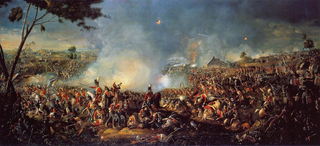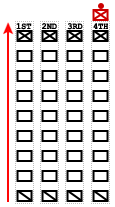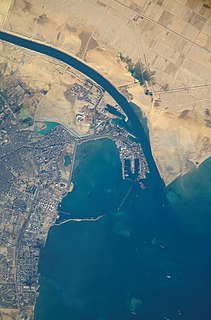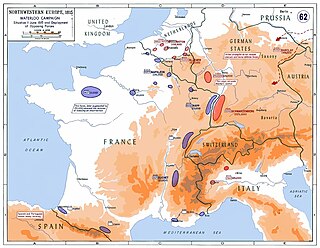
The Battle of Waterloo was fought on Sunday 18 June 1815, near Waterloo. A French army under the command of Napoleon was defeated by two of the armies of the Seventh Coalition. One of these was a British-led coalition consisting of units from the United Kingdom, the Netherlands, Hanover, Brunswick, and Nassau, under the command of the Duke of Wellington. The other was composed of three corps of the Prussian army under the command of Field Marshal von Blücher. The battle marked the end of the Napoleonic Wars. The battle was contemporaneously known as the Battle of Mont Saint-Jean (France) or La Belle Alliance.

The Battle of Ligny, in which French troops of the Armée du Nord under the command of Napoleon I defeated part of a Prussian army under Field Marshal Blücher, was fought on 16 June 1815 near Ligny in what is now Belgium. The result was a tactical victory for the French, but the bulk of the Prussian army survived the battle in good order, was reinforced by Prussian troops who had not fought at Ligny, and played a role two days later at the Battle of Waterloo. The Battle of Ligny was the last victory in Napoleon's military career.

The Hundred Days, also known as the War of the Seventh Coalition, marked the period between Napoleon's return from eleven months of exile on the island of Elba to Paris on 20 March 1815 and the second restoration of King Louis XVIII on 8 July 1815. This period saw the War of the Seventh Coalition, and includes the Waterloo Campaign, the Neapolitan War as well as several other minor campaigns. The phrase les Cent Jours was first used by the prefect of Paris, Gaspard, comte de Chabrol, in his speech welcoming the king back to Paris on 8 July.

The Battle of Quatre Bras was fought on 16 June 1815, as a preliminary engagement to the decisive Battle of Waterloo that occurred two days later. The battle took place near the strategic crossroads of Quatre Bras and was contested between elements of the Duke of Wellington's Anglo-allied army and the left wing of Napoleon Bonaparte's French Armée du Nord under Marshal Michel Ney. The battle was a tactical victory for Wellington, but because Ney prevented him going to the aid of Blucher's Prussians who were fighting a larger French army under the command of Napoleon Bonaparte at Ligny it was a strategic victory for the French.

The Battle of Wavre was the final major military action of the Hundred Days campaign and the Napoleonic Wars. It was fought on 18–19 June 1815 between the Prussian rearguard, consisting of the Prussian III Corps under the command of General Johann von Thielmann and three corps of the French army under the command of Marshal Grouchy. A blocking action, this battle kept 33,000 French soldiers from reaching the Battle of Waterloo and so helped in the defeat of Napoleon at Waterloo.

The Waterloo campaign was fought between the French Army of the North and two Seventh Coalition armies, an Anglo-allied army and a Prussian army. Initially the French army was commanded by Napoleon Bonaparte, but he left for Paris after the French defeat at the Battle of Waterloo. Command then rested on Marshals Soult and Grouchy, who were in turn replaced by Marshal Davout, who took command at the request of the French Provisional Government. The Anglo-allied army was commanded by the Duke of Wellington and the Prussian army by Prince Blücher.

An infantry square, also known as a hollow square, was a historic combat formation in which an infantry unit formed in close order, usually when it was threatened with cavalry attack. As a traditional infantry unit generally formed a line to advance, more nimble cavalry could sweep around the end of the line and attack from the undefended rear or burst through the line, with much the same effect. By arranging the unit so that there was no undefended rear, a commander could organise an effective defense against a cavalry attack. With the development of modern firearms and the demise of cavalry, that formation is now considered obsolete.

This is the complete order of battle for the four major battles of the Waterloo campaign.

A military column is a formation of soldiers marching together in one or more files in which the file is significantly longer than the width of ranks in the formation. The column formation allows the unit rapid movement and a very effective charge, and it can quickly form square to resist cavalry attacks, but by its nature only a fraction of its muskets are able to open fire.

Dmitry Sergeyevich Dokhturov was a Russian infantry general and a prominent military leader during the Patriotic War of 1812.

In hydrology, a debouch is a place where runoff from a small, confined space discharges into a larger, broader body of water. The word is derived from the French verb déboucher, which means "to unblock, to clear". The term also has a military usage.

The Battle of Rocquencourt was a cavalry skirmish fought on 1 July 1815 in and around the villages of Rocquencourt and Le Chesnay. French dragoons supported by infantry and commanded by General Exelmans destroyed a Prussian brigade of hussars under the command of Lieutenant Colonel Eston von Sohr.
James Graham (1791–1845) was an Irish non-commissioned officer (NCO) in the British Army during the Napoleonic Wars, recognised as the "bravest man in the army". Serving in the Coldstream Guards, he was commended for his gallantry during the defence of Hougoumont, at Waterloo. Graham saved the life of an officer, and his own brother, and was among the small group responsible for closing the North Gate at Hougoumont after a French attack – an act which won the Duke of Wellington's encomium. He was rewarded with a specially cast gallantry medal and an annuity. After later serving in the 12th Royal Lancers, Graham was discharged in 1830 for ill health, and died at the Royal Hospital Kilmainham in 1845.

On 1 March 1815 Napoleon Bonaparte escaped from his imprisonment on the isle of Elba, and launched a bid to recover his empire. A confederation of European powers pledged to stop him. During the period known as the Hundred Days Napoleon chose to confront the armies of Prince Blücher and the Duke of Wellington in what has become known as the Waterloo Campaign. He was decisively defeated by the two allied armies at the Battle of Waterloo, which then marched on Paris forcing Napoleon to abdicate for the second time. However Russia, Austria and some of the minor German states also fielded armies against him and all of them also invaded France. Of these other armies the ones engaged in the largest campaigns and saw the most fighting were two Austrian armies: The Army of the Upper Rhine and the Army of Italy.
William Siborne, Sibourne or Siborn was a British officer and military historian whose most notable work was a history of the Waterloo Campaign.

Horses were widely used during the Napoleonic Wars for combat, patrol and reconnaissance, and for logistical support. Vast numbers were used throughout the wars. During the War of the Sixth Coalition, depletion of the French cavalry arm through attrition and loss of horse-producing allies to provide remounts contributed significantly to the gradual French defeat and downfall of the French Empire. During the Waterloo Campaign, the Armee du Nord had 47,000 horses: 25,000 cavalry, 12,000 for artillery, 10,000 for infantry and supply columns.

The Waterloo campaign commenced with a pre-emptive attack by the French Army of the North under the command of Napoleon Bonaparte. The first elements of the Army of the North moved from their peacetime depots on 8 June to their rendezvous point just on the French side of the Franco-Belgian border. They launched a pre-emptive attack on the two Coalition armies that were cantoned in Belgium—the Anglo-allied army under the command of the Duke of Wellington, and a Prussian army under the command of Prince Blücher.

After the fighting at Quatre Bras the two opposing commanders Marshal Ney and the Duke of Wellington initially held their ground while they obtained information about what had happened at the larger Battle of Ligny. They received intelligence that the Prussian army under the command of Prince Blücher had been defeated by the French Army of the North under the command of Napoleon Bonaparte.

On 16 June 1815, the French defeated the Prussians at the Battle of Ligny. The Prussians successfully disengaged and withdrew north to Wavre where they regrouped, and later advanced westward with three corps to attack the right flank of the French army at the Battle of Waterloo. The French were slow to exploit Ligny; Napoleon wasted the morning of 17 June with a late breakfast and touring the previous day's battlefield before organising a pursuit of the two Coalition armies. Napoleon and Marshal Michel Ney took the French reserves to pursue the Duke of Wellington's Anglo-allied army. Marshal Emmanuel de Grouchy was ordered to pursue and harry the Prussians and prevent them from regrouping.

After their defeat at the Battle of Waterloo on 18 June 1815, the French Army of the North, under the command of Napoleon Bonaparte retreated in disarray back towards France. As agreed by the two Seventh Coalition commanders in chief, the Duke of Wellington, commander of the Anglo-allied army, and Prince Blücher, commander of the Prussian army, the French were to be closely pursued by units of the Prussian cavalry.














